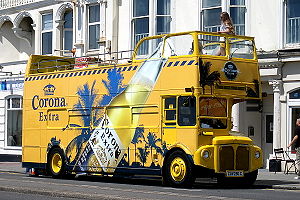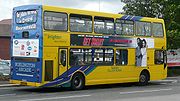
Bus advertising
Encyclopedia

Bus
A bus is a road vehicle designed to carry passengers. Buses can have a capacity as high as 300 passengers. The most common type of bus is the single-decker bus, with larger loads carried by double-decker buses and articulated buses, and smaller loads carried by midibuses and minibuses; coaches are...
es and their related infrastructure is a medium commonly used by advertisers
Advertising
Advertising is a form of communication used to persuade an audience to take some action with respect to products, ideas, or services. Most commonly, the desired result is to drive consumer behavior with respect to a commercial offering, although political and ideological advertising is also common...
to reach the public with their message. Usually, this takes the form of promoting commercial brand
Brand
The American Marketing Association defines a brand as a "Name, term, design, symbol, or any other feature that identifies one seller's good or service as distinct from those of other sellers."...
s, but can also be used for public campaign messages. Buses may also be used as part of a political or promotional campaign, or as a tool in a commercial enterprise.
History
Bus advertising descends from similar methods used on streetcars in the early 20th century.Infrastructure

Adverts may also be installed on associated street furniture such as the backs of bench
Bench (furniture)
A bench is a piece of furniture, on which several people may sit at the same time. Benches are typically made of wood, but may also be made of metal, stone, or synthetic materials. Many benches have arm and back rests; some have no back rest and can be sat on from either side. In public areas,...
es at stops.
Tickets
Often, the paper bus ticketTicket (admission)
A ticket is a voucher that indicates that one has paid for admission to an event or establishment such as a theatre, movie theater, amusement park, zoo, museum, concert, or other attraction, or permission to travel on a vehicle such as an airliner, train, bus, or boat, typically because one has...
is used as an advertising space. The ticket rolls for the ticket machine
Ticket machine
A ticket machine, also known as a ticket vending machine , is a vending machine that produces tickets. For instance, ticket machines dispense train tickets at railway stations and tram tickets at some tram stops and in some trams...
s are pre-printed on the rear with a particular company's advert.
Bus interiors
A common location for adverts is inside the bus. Adverts are attached to the corners between the walls and ceiling overhead to catch the eye of passengers, in the same manner as used in rapid transitRapid transit
A rapid transit, underground, subway, elevated railway, metro or metropolitan railway system is an electric passenger railway in an urban area with a high capacity and frequency, and grade separation from other traffic. Rapid transit systems are typically located either in underground tunnels or on...
systems.
Increasingly, companies are using interior television
Television
Television is a telecommunication medium for transmitting and receiving moving images that can be monochrome or colored, with accompanying sound...
systems to advertise.
Bus exteriors

Panels
Adverts are often placed as basic rectangular motifs on the side or front of a bus. These may be applied directly to the bus. Additionally, adverts may be printed on placards known as boards, which are slotted into special guide fittings attached to the side of the bus.Partial and full adverts
Occasionally, the entire surface of a bus is turned into an advertisement. This can be a whole side or rear of a bus, or a scheme applied to the entire exterior, known as an 'all-over advert' bus.Technologies

Paint
Paint is any liquid, liquefiable, or mastic composition which after application to a substrate in a thin layer is converted to an opaque solid film. One may also consider the digital mimicry thereof...
ed on if the length of application warranted it. This would require a reasonable longevity and cost implication for advertisers, due to the requirement to take buses out of service to apply and remove paint schemes. Frequently changed panel adverts would use replaceable boards.
With the advent of adhesive vinyl
Vinyl
A vinyl compound is any organic compound that contains a vinyl group ,which are derivatives of ethene, CH2=CH2, with one hydrogen atom replaced with some other group...
technologies, this allowed adverts to be rapidly applied and removed over the top of the buses exterior paint as decal
Decal
A decal or transfer is a plastic, cloth, paper or ceramic substrate that has printed on it a pattern or image that can be moved to another surface upon contact, usually with the aid of heat or water. The word is short for decalcomania...
s, reducing the cost and time.
The introduction of perforated and directionally transparent vinyl sheets allowed the creation of more elaborate designs that could be applied over windows (although for safety reasons not the front window), moving away from the traditional square box design approach to adverts.
With the advent of partially transparent window coverage techniques, all over adverts have been applied as a full vehicle advertising wrap windows and all. The transition from screen printing to digital printing
Digital printing
Digital printing refers to methods of printing from a digital based image directly to a variety of media. It usually refers to professional printing where small run jobs from desktop publishing and other digital sources are printed using large format and/or high volume laser or inkjet printers...
has seen an increase in the color range and complexity of advert designs.
Campaign and Promotion buses
In addition to public transportPublic transport
Public transport is a shared passenger transportation service which is available for use by the general public, as distinct from modes such as taxicab, car pooling or hired buses which are not shared by strangers without private arrangement.Public transport modes include buses, trolleybuses, trams...
buses, all-over advert buses are often privately hired specifically for a special promotional use, such as a political campaign
Political campaign
A political campaign is an organized effort which seeks to influence the decision making process within a specific group. In democracies, political campaigns often refer to electoral campaigns, wherein representatives are chosen or referendums are decided...
or specific product promotions. These will often make use of open top bus
Open top bus
An open top bus is a bus, usually but not exclusively a double-decker bus, where all or part of the roof has been removed to enable enjoyment of fresh air and uninterrupted views.-Usage:...
es to allow the interaction of the campaigners/promoters with the public.
Legal issues
In NorwayNorway
Norway , officially the Kingdom of Norway, is a Nordic unitary constitutional monarchy whose territory comprises the western portion of the Scandinavian Peninsula, Jan Mayen, and the Arctic archipelago of Svalbard and Bouvet Island. Norway has a total area of and a population of about 4.9 million...
, the use of wrap advertising on buses was prohibited by the road authorities. The reason behind the ban was that in an emergency the windows might need to serve as an emergency exit
Emergency exit
An emergency exit in a structure is a special exit for emergencies such as a fire: the combined use of regular and special exits allows for faster evacuation, while it also provides an alternative if the route to the regular exit is blocked by fire, etc....
, and that the advertising would make the window harder to break with the emergency hammer
Emergency hammer
An emergency hammer is a safety device used in vehicles to break through window glass in an emergency.It is a simple tool with a plastic handles and steel tip. Its primary use is for breaking through vehicle windows, which are often tempered, in the event of a crash which prevents exit through the...
. Gaia Trafikk
Gaia Trafikk
Gaia Trafikk was the largest public transportation provider in Bergen and Os, Norway until it merged with HSD forming Tide.Gaia was formed by the 1998 merger of Pan Trafikk, the bus company serving northern and southern Bergen, and Bergen Sporvei, the company serving Bergen's inner city...
argued against the ban, pointing out that their tests showed that the thin wrap had no impact on the breakability of the window, but did remove the advertising which covered the windows.
See also
- Driven mediaDriven mediaDriven media is the practice of covering or wrapping any vehicle in vibrant, custom-designed vinyl sheets, turning a vehicle into a mobile billboard. The purpose of this is to provide advertising impressions...
- Mobile billboardMobile billboardA mobile billboard is a device within the marketing practice of advertising on the side of a truck or trailer that is typically mobile. Mobile billboards are a form of Out-Of-Home Advertising. Radio, static billboards, and mall/airport advertising fall into the same category...
- Wrap advertisingWrap advertisingWrap advertising is the marketing practice of completely or partially covering a vehicle in an advertisement or livery, thus turning it into a mobile billboard. This can be achieved by simply painting the vehicle surface, but it is becoming more common today to use large vinyl sheets as decals...

